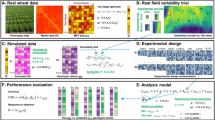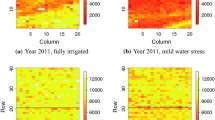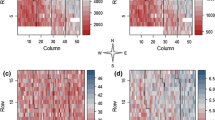Abstract
Appropriate analysis of plant breeding trials is critical for the accurate assessment of test lines and selection decisions. The objectives of this study were two-fold: firstly, to examine the performance of two-dimensional spatial models based on the first order separable autoregressive process in comparison with randomised complete block (RCB) and randomisation based (RB) models in analysis of cotton breeding trials; secondly, to understand the presence and forms of spatial variations and their association with field layout. The different models were first used to analyse a lint yield dataset from the CSIRO cotton breeding program, which consisted of 96 trials under furrow-irrigated conditions from 1995 to 2002 and Residual Maximum Likelihood ratio test and the Akaike Information Criterion were used to identify adequate model (i.e. dataset-preferred model) for individual datasets. The spatial models fitted 62 trials adequately and outperformed the RB model (31) with the worse being RCB model (3). Spatial variations in various forms were commonly present in trials in which spatial models were adequate, and was dominant in planting row direction. Layouts with more plots in dimensional directions tended to have a higher level of spatial variation. Spatial models offered about 176 % mean relative efficiency over RCB, which was comparable with that achieved by the dataset-preferred models but about 20 % higher than the RB model. Therefore, a routine use of spatial analysis in conjunction with efficient trial designs would mitigate the impact of spatial variations on the yield estimate of cotton breeding trials and improve the accuracy of selection.




Similar content being viewed by others
References
Beeck CP, Cowling WA, Smith AB, Cullis BR (2010) Analysis of yield and oil from a series of canola breeding trials. Part I. Fitting factor analytic mixed models with pedigree information. Genome 53:992–1001. doi:10.1139/G10-051
Bowman DT (1989) Use of trend analysis to improve the precision in yield trials. In: Dugger CP, Richter DA (eds) Proceedings of beltwide cotton production and research conference, Tennessee, pp 123–124, 3–6 January 1989
Brownie C, Bowman DT, Burton JW (1993) Estimating spatial variation in analysis of data from yield trials: a comparison of methods. Agron J 85:1244–1253
Butler DG, Cullis BR, Gilmour AR, Gogel BJ (2009) ASREML-R Reference Manual. Queensland Department of Primary Industries and Fisheries, NSW Department of Primary Industries, Training Series QE02001, 3rd edn. The State of Queensland, Department of Primary Industries and Fisheries
Calhoun DS, Bowman DT (1999) Techniques for development of new cultivars. In: Smith CW, Cothren JT (eds) Cotton: origin, history, technology, and production. Wiley, New York, pp 361–414
Campbell BT, Bauer PJ (2007) Improving the precision of cotton performance trials conducted on highly variable soils of the southeastern USA coastal plain. Plant Breed 126:622–627
Cullis BR, Gleeson AC (1989) Efficiency of neighbour analysis for replicated variety trials in Australia. J Agric Sci Camb 113:233–239
Cullis BR, Gleeson AC (1991) Spatial analysis of field experiments-An extension to two dimensions. Biometrics 47:1449–1460
Cullis B, Gogel B, Verbyla A, Thompson R (1998) Spatial analysis of multi-environment early generation variety trials. Biometrics 54:1–18
Gilmour AR, Cullis BR, Verbyla AP (1997) Accounting for natural and extraneous variation in the analysis of field experiments. J Agric Biol Environ Stat 2:269–293
Gleeson AC (1997) Spatial analysis. In: Kempton RA, Fox PN (eds) Statistical methods for plant variety evaluation. Chapman and Hall, London, pp 68–85
Gleeson AC, Cullis BR (1987) Residual maximum likelihood (REML) estimation of a neighbour model for field experiments. Biometrics 43:277–287
Kempton RA, Seraphin JC, Sword AM (1994) Statistical analysis of two-dimensional variation in variety yield trials. J Agric Sci Camb 122:335–342
Liu SM, Constable GA, Reid PE, Stiller WN, Cullis BR (2013) The interaction between breeding and crop management in improved cotton yield. Field Crops Res 148:49–60. doi:10.1016/j.fcr.2013.04.006
Luckett DJ, Williams ER, Reid PE, Thomson NJ (1992) Irrigated plot trials in cotton: quantifying end effects and the influence of plot size upon intergenotypic competition. Aust J Agric Res 43:181–190. doi:10.1071/AR9920181
Mead R (1997) Design of plant breeding trials. In: Kempton RA, Fox PN (eds) Statistical methods for plant variety evaluation. Chapman and Hall, London, pp 40–67
Mohring J, Piepho HP (2009) Comparison of weighting in two-stage analysis of plant breeding trials. Crop Sci 49:1977–1988. doi:10.2135/cropsci2009.02.0083
Muller BU, Kleinknecht K, Mohring J, Piepho HP (2010) Comparison of spatial models for sugar beet and barley trials. Crop Sci 50:794–802. doi:10.2135/cropsci2009.03.0153
Patterson HD, Silvey V (1980) Statutory and recommended list trials of crop varieties in the UK (with discussion). J R Stat Soc Ser A(General) 143:219–252
Piepho HP, Williams ER (2010) Linear variance models for plant breeding trials. Plant Breed 129:1–8
Piepho HP, Richter C, Williams E (2008) Nearest neighbour adjustment and linear variance models in plant breeding trials. Biom J 50:164–189
Robinson DL, Kershaw CD, Ellis RP (1988) An investigation of two-dimensional yield variability in breeders small plot barley trials. J Agric Sci Camb 111:419–426
Smith A, Cullis B, Gilmour A (2001) The analysis of crop variety evaluation data in Australia. Aust N Z J Stat 43:129–145
Smith AB, Cullis BR, Thompson R (2005) The analysis of crop cultivar breeding and evaluation trials: an overview of current mixed model approaches. J Agric Sci Camb 143:449–462
Spilke J, Richter C, Piepho HP (2010) Model selection and its consequences for different split-plot designs with spatial covariance and trend. Plant Breed 129:590–598. doi:10.1111/j.1439-0523.2010.01795.x
Stefanova KT, Smith AB, Cullis BR (2009) Enhanced diagnostics for the spatial analysis of field trials. J Agric Biol Environ Stat 14:392–410. doi:10.2307/20696584
Stringer JK, Cullis BR (2002) Application of spatial analysis techniques to adjust for fertility trends and identify interplot competition in early stage sugarcane selection trials. Aust J Agric Res 53:911–918. doi:10.1071/AR01151
Waddle BA (1984) Crop growing practices. In: Kohel RJ, Lewis CF (eds) Cotton. ASA, CSSA and SSSA, Madison pp 233–263
Welham SJ, Gogel BJ, Smith AB, Thompson R, Cullis BR (2010) A comparison of analysis methods for late-stage variety evaluation trials. Aust N Z J Stat 52:125–149
Whitaker D, Williams ER, John JA (2002) CycDesigN: a package for the computer generation of experimental designs. CSIRO Forestry and Forest Products, Canberra
Wilkinson GN, Eckert SR, Hancock TW, Mayo O (1983) Nearest neighbour (NN) analysis of field experiments. J R Stat Soc Ser B 45:151–211
Williams ER (1986a) A neighbour model for field experiments. Biometrika 73:279–287
Williams ER (1986b) Row and column designs with contiguous replicates. Aust J Stat 28:154–163
Williams ER, John JA (1989) Construction of row and column designs with contiguous replicates. J R Stat Soc Ser C 38:149–154
Williams ER, Luckett DJ (1988) The use of uniformity data in the design and analysis of cotton and barley variety trials. Aust J Agric Res 39:339–350. doi:10.1071/AR9880339
Wolfinger RD (1996) Heterogeneous variance-covariance structures for repeated measures. J Agric Biol Environ Stat 1:205–230
Acknowledgments
The authors acknowledge the assistance of all the co-operators to conduct cotton ALTs on their farms and technical support of our past and present CSIRO team members: Lindsay Heal, Chris Tyson, Kellie Cooper, Dave Shann, Chris Allen, Max Barnes, Kay Smith, Sandra Magann, and Megan Smith; as well as Gavin Mann of QDEEDI. The authors are thankful to Dr Alison Smith, The University of Wollongong for her advice and help in data analysis. The authors also thank Mr. Alec Zwart, CSIRO Computational Informatics and two anonymous reviewers for their comments improved the manuscript. The Cotton Research and Development Corporation provided funding support for these experiments.
Author information
Authors and Affiliations
Corresponding author
Rights and permissions
About this article
Cite this article
Liu, S.M., Constable, G.A., Cullis, B.R. et al. Benefit of spatial analysis for furrow irrigated cotton breeding trials. Euphytica 201, 253–264 (2015). https://doi.org/10.1007/s10681-014-1205-2
Received:
Accepted:
Published:
Issue Date:
DOI: https://doi.org/10.1007/s10681-014-1205-2




